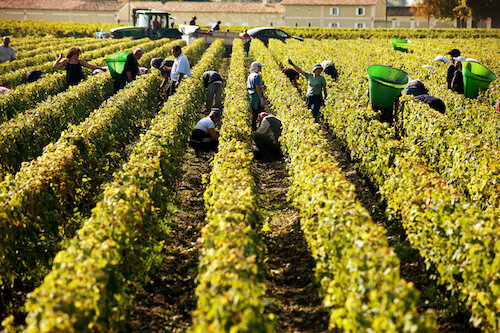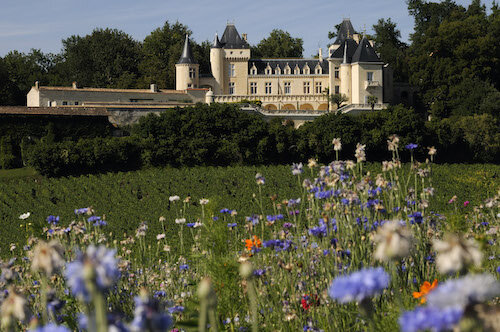What Does Bordeaux En Primeurs Look Like in 2021?
harvest photo credit CIVB
Bordeaux wine is like the Big Bang Theory or Newton’s Laws of Motion. Universe-defining, omnipresent, and to many of us, if we’re honest, a bit mysterious. But by the time we reach full-blown adulthood, if we haven’t already absorbed an understanding of these great hulking entities, we don’t really want to admit it.
But Bordeaux is worth the blush: it is the largest, the most important and some would argue, the best of French wine regions. Even a superficial understanding of the inner workings of the place will be rewarded with a lifetime of extraordinary, and far less expensive than you suspect, sips. (For a brief overview of Bordeaux’s history, grapes, and classification system, see our Postcard From Bordeaux, below).
Bordeaux has, for centuries, always influenced and sometimes defined wine farming, production, and culture. COVID has threatened the dominance of the region by transforming the way it reaches the market. Surprising precisely no one, Bordeaux’s route to market is as exacting—and from the outside, often inexplicable—as its systems of classifications and rules.
But surprising many, just as Bordeaux has agreed to loosen some of its planting and farming regulations to accommodate the challenges of climate change, the region has also agreed to adjust its rigid En Primeurs campaign to facilitate the changing needs of a socially distant market.
How Bordeaux En Primeurs Works
The classic En Primeurs is essentially a sauced-up, gilded form of Community Supported Agriculture (CSA). Here’s what used to happen: wine buyers and critics would descend on the region to taste barrel samples from the previous year’s vintage. The wine is not “finished,” still requiring about 18 months in barrel before being bottled. But experienced buyers and critics could get a sense of what was to come; critics would issue forecasts for collectors, but more essentially, merchants would pre-buy wines that would land in the marketplace two years later.
But unlike your aggressively laid-back CSA pick-up, En Primeurs resembles the Oscars, crossed with rush week and the U.N. General Assembly. Thousands of delighted wine enthusiasts descend on Bordeaux to jockey for meetings at historic châteaux, compete over swirling and sniffing room at barrels and attend fancy dress parties well into the wee hours of the night.
En Primeurs is simply put, a fun and unabashedly glamorous opportunity for networking, but also the most important—often the only—way winemakers have to ensure a steady flow of cash. Buyers go for the experience and the “deal.” Estimates vary, but early buyers can expect an average of a 20% return on their investment, depending on prevailing market conditions and the quality of the vintage, when they sell the wines in the coming years.
“For decades, it has been the best way to sell and have access to the Bordeaux Grand Cru Classé world at the best price,” says Jean-Christophe Meyrou, Director General of Vignobles K, which encompasses seven Chateaus on the Right Bank. “For us, it represents a significant part of our business, with a sales target of 60% of our production every year.”
COVID’S Impact on En Primeurs
Last year, COVID transformed the in-person bacchanal into a series of tastings conducted over Zoom. Le sigh.
This year, Ronan Laborde, president of the Union des Grands Crus de Bordeaux (UGCB), is, like many other cultural festivals that entire industries rely upon, trying to blend virtual and in-person elements.
“We were anxious about whether the virtual meetings last year would work, but we found that the sales went extremely well,” Laborde says. “This year, instead of doing En Primeurs entirely in Bordeaux or just online, we decided to present the 2020 En Primeurs three weeks later than usual, in 10 cities across the world.
Between April 26-April 29th, wine professionals in Bordeaux, Paris, Hong Kong, Frankfurt, New York, San Francisco, Brussels, Shanghai, and Hong Kong—cities that account for 75% of Great Growth wine customers—will taste the wines produced by the UGCB’s 131 member estates. The wines will be served in accordance with local health regulations and will arrive via glass and plastic tubes.
“Buying En Primeurs is the best, and sometimes the only, way for people and companies to purchase these products,” says Laborde.
Meyrou concurs, and while he wishes Bordeaux could welcome everyone, he acknowledges that “buyers and press cannot technically come to France due to COVID. The different associations and many wineries, like us, will send the samples directly to buyers and opinion makers. This is a difficult task because barrel samples are super fragile, with a very limited life expectancy after shipment. But last year was good training, we think this year will be even better.”
The 2020 vintage has been deemed extraordinary by growers and the UGCB. Laborde says that the dry conditions and relatively steady temperatures will deliver “delicious and exciting” bottles to a thirsty public.
It is incredible to think that a region so enmeshed in tradition could manage to pivot from a historic regional festival with tens of thousands of attendees responsible for tens of millions of dollars in wine purchase to a blend of virtual and in-person events across the globe. But COVID has, in addition to delivering more economic and emotional hardship than the world has faced in generations, inspired even the most notoriously averse to change, to look at the world in a different way.
Postcard From Bordeaux: The History, the Grapes, the Classifications
Petit verdot photo courtesy CIVB
Here is what you absolutely should know, and not for a second feel silly for not knowing:
· Ausonius (310-394) is the first known wine-grower and poet-ambassador of the region. His estate is thought to have been located near the river Garonne. His poems, including Mosella and De Herediolo, make it clear that acreage had been under vine here for some time, but this was the first written evidence of it.
· There are 65 appellations across Bordeaux. The Left Bank appellations are on the Atlantic Ocean side of the rivers Gironde and Garonne, while the Right Bank sprawl to the right of the Dordogne River, which then leads to the Gironde.
· Bordeaux is France’s largest appellation d’origine controlee (AOC) area, making up 25% of the country’s AOC vineyards, but only 14% of its total wine-growing area.
· Bordeaux represents about 2% of the world’s wine production, with 5,800 winegrowers, 300 negociants, 72 brokers and 29 cooperatives within its bounds.
· In general, cabernet sauvignon dominates the wines of the Left Bank. Merlot dominates the wines of the Right Bank. Other red grape varieties: cabernet franc, petit verdot, malbec, carmenere.
· Approved white varieties are semillon, sauvignon blanc, sauvignon gris, muscadelle, colombard, ugni blanc, merlot blanc, and nauzac.
· About 85% of Bordeaux’s production is red, 10% is dry white or Crémant de Bordeaux; rosés, clairets and Crémant de Bordeaux comprise 4% and sweet Bordeaux whites make up the remaining 1%.
· In 2021, France’s Institut National de l'Origine et de la Qualite (INAO) approved six new varieties, in what many see as a stark acknowledgement of the realities of climate change. Four reds— arinarnoa, castets, marselan, and Touriga Nacional—and two whites—alvarinho and liliorila—have been approved to combat “temperature increases and shorter growing cycles.”
· French wine labels indicate the region the wine is produced. Cru means “growth,” but signifies the quality of the vineyard.
· In Bordeaux, the Grand Cru Classé designation is tied to a chateau or estate, not a vineyard. The classification was created in 1855, encompassing left bank chateaus Médoc, Graves, and Sauternes, all ranked from first to fifth growths. First growths are premiers crus (the best of the best), and second, to fifth are crus classes. Only about 5% of the vineyard are in Bordeaux is dedicated to growing cru classes.
· The right bank doesn’t classify Pomerol, only Saint-Émilion. Saint-Émilion has two chateau-based quality classifications, top dog Premier Grands Cru Classés and Grand Crus Classés, with 18 and 64 chateaus respectively. There is also a third category, Saint-Émilion Grand Cru, which is not linked to a chateau or growing region, but instead to production rules.



